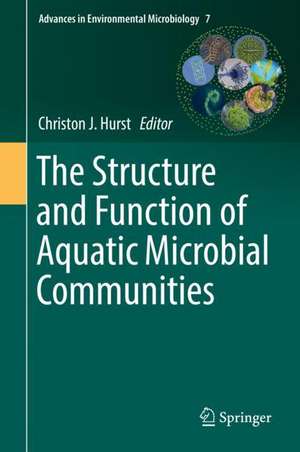The Structure and Function of Aquatic Microbial Communities: Advances in Environmental Microbiology, cartea 7
Editat de Christon J. Hursten Limba Engleză Hardback – 24 mai 2019
Preț: 1117.34 lei
Preț vechi: 1362.61 lei
-18% Nou
Puncte Express: 1676
Preț estimativ în valută:
213.83€ • 222.42$ • 176.53£
213.83€ • 222.42$ • 176.53£
Carte tipărită la comandă
Livrare economică 14-28 aprilie
Preluare comenzi: 021 569.72.76
Specificații
ISBN-13: 9783030167738
ISBN-10: 3030167739
Pagini: 380
Ilustrații: XIII, 351 p. 100 illus., 38 illus. in color.
Dimensiuni: 155 x 235 mm
Greutate: 0.69 kg
Ediția:1st ed. 2019
Editura: Springer International Publishing
Colecția Springer
Seria Advances in Environmental Microbiology
Locul publicării:Cham, Switzerland
ISBN-10: 3030167739
Pagini: 380
Ilustrații: XIII, 351 p. 100 illus., 38 illus. in color.
Dimensiuni: 155 x 235 mm
Greutate: 0.69 kg
Ediția:1st ed. 2019
Editura: Springer International Publishing
Colecția Springer
Seria Advances in Environmental Microbiology
Locul publicării:Cham, Switzerland
Cuprins
- Understanding Aquatic Microbial Communities. - Relationship Between Lifestyle and Structure of Bacterial Communities and Their Functionality in Aquatic Systems. - Biofilms: Besieged Cities or Thriving Ports?. - Complex Structure but Simple Function in Microbial Mats from Antarctic Lakes. - Fungal Decomposers in Freshwater Environments. - The Ecology of Methanogenic Archaea in a Nutrient-Impacted Wetland. - Briefly Summarizing Our Understanding of Vibrio cholerae and the Disease Cholera. - Options for Providing Microbiologically Safe Drinking Water. - Microbiome of Drinking Water Distribution Systems. - Isolation and Cultivation of Bacteria.
Notă biografică
Christon J. HurstCincinnati, Ohio, USA
and
Universidad del Valle, Santiago de Cali, Valle, Colombia
and
Universidad del Valle, Santiago de Cali, Valle, Colombia
e-mail: christonjhurst@fuse.net
Textul de pe ultima copertă
This book discusses how aquatic microbial communities develop interactive metabolic coordination both within and between species to optimize their energetics. It explains that microbial community structuration often includes functional stratification among a multitude of organisms that variously exist either suspended in the water, lodged in sediments, or bound to one another as biofilms on solid surfaces. The authors describe techniques that can be used for preparing and distributing microbiologically safe drinking water, which presents the challenge of successfully removing the pathogenic members of the aquatic microbial community and then safely delivering that water to consumers. Drinking water distribution systems have their own microbial ecology, which we must both understand and control in order to maintain the safety of the water supply. Since studying aquatic microorganisms often entails identifying them, the book also discusses techniques for successfully isolating and cultivating bacteria. As such, it appeals to microbiologists, microbial ecologists and water quality scientists.
Caracteristici
Provides new insights into the structure of microbial communities Discusses techniques for preparing and distributing microbiologically safe drinking water Describes techniques for isolating and cultivating microbes









